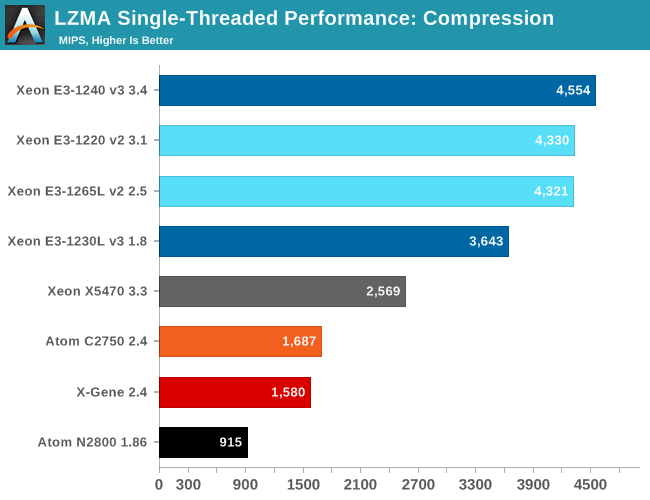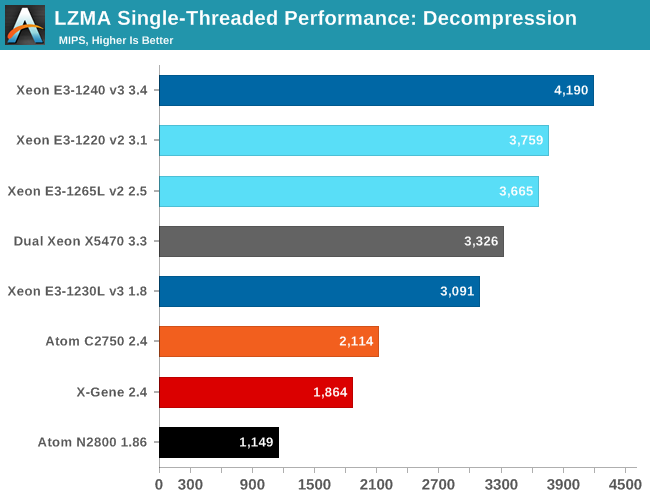X-Gene 1, Atom C2000 and Xeon E3: Exploring the Scale-Out Server World
by Johan De Gelas on March 9, 2015 2:00 PM ESTSingle-Threaded Integer Performance
The LZMA compression benchmark only measures a part of the performance of some real-world server applications (file server, backup, etc.). The reason why we keep using this benchmark is that it allows us to isolate the "hard to extract instruction level parallelism (ILP)" and "sensitive to memory parallelism and latency" integer performance. That is the kind of integer performance you need in most server applications.
This is more or less the worst-case scenario for "brawny" cores like Haswell or Power 8. Or in other words, it should be the best-case scenario for a less wide "energy optimized" ARM or Atom core, as the wide issue cores cannot achieve their full potential.
One more reason to test performance in this manner is that the 7-zip source code is available under the GNU LGPL license. That allows us to recompile the source code on every machine with the -O2 optimization with gcc 4.8.2.

Despite the fact that the X-Gene has a 4-wide core, it is not able to outperform the dual issue Atom "Silvermont" core. Which is disappointing, considering that the AppliedMicro marketing claimed that the X-Gene would reach Xeon E5 levels. A 2.4GHz "Penryn/Harpertown" core reaches about 1860, which means that the X-Gene core still has a lot of catching up to do. It is nowhere near the performance levels of Ivy Bridge or Haswell.
Of course, the ARM ecosystem is still in its infancy. We tried out the new gcc 4.9.2, which has better support for AArch64. Compression became 6% faster, however decompression performance regressed by 4%....
Both the Xeon E3-1265L and E3-1220 v2 can boost to 3.5GHz, so they offer the same integer performance. The only reason that the Xeon E3-1240 v3 can offer higher performance is the slightly higher clock (3.8GHz Turbo Boost). The ultra efficient Xeon E3-1230L is capable of offering 80% of the performance of the 80W Xeon E3-1240. That is an excellent start.
As a long-time CPU enthusiast, you'll forgive me if I find the progress that Intel made from the 45nm "Harpertown" (X5470) to 22nm Xeon E3-1200 v3 pretty impressive. If we disable Turbo Boost, the Xeon E3-1240 at 3.4GHz achieves about 4200. This means that the Haswell architecture has an IPC that is no less than 63% better while running "IPC unfriendly" software.
The Xeon E3-1230L and Atom C2750 run at similar clock speeds in this single threaded task (2.8GHz vs 2.6GHz), but you can see how much difference a wide complex architecture makes. The Haswell Core is able to run about twice as many instructions in parallel as the Silvermont core. Meanwhile the Silvermont core is about 45% more efficient clock for clock than the old Saltwell core of the Atom N2800. The Haswell core result clearly shows that well designed wide architectures remain quite capable in "high ILP" (Instruction Level Parallelism) code.
Let's see how the chips compare in decompression. Decompression is an even lower IPC (Instructions Per Clock) workload, as it is pretty branch intensive and depends on the latencies of the multiply and shift instructions.

Decompression uses a rather exotic instruction mix and the progress made here is much smaller. The Haswell core is about 15% faster clock for clock than the old Harpertown core. Compared to the Silvermont core, the Haswell core is about 40% more efficient in this kind of software. The X-Gene core is about 10% slower than the Atom C2000.










47 Comments
View All Comments
IBleedOrange - Monday, March 9, 2015 - link
EETimes is wrong.Google "Intel Denverton"
beginner99 - Monday, March 9, 2015 - link
Maybe it would be good to mention the X-Gene is made on a 40nm process at the start of the article. I read the article and think for myself that the X-Gene is crap and in the end you get the explanation. It's on 40 nm vs Atoms on Intel 22 nm. It's a huge difference and currently the article is a bit misleading eg. shining a bad light on X-Gene and ARM. (And I say this even though I always was a proponent of Intel Big cores in almost all server applications).Stephen Barrett - Monday, March 9, 2015 - link
If APM had a newer part to test then we would have tested it. XG2 is simply not out yet. So the fact that APM has their flagship SoC on an older process is not misleading... Its the facts. The currently available Intel parts have a process advantage.warreo - Monday, March 9, 2015 - link
Mentioning it at the start would be good from a technical disclosure standpoint, but I'm not sure for the purposes of this article it truly matters. The article is comparing what is currently available now from APM and Intel. Reality is Intel will likely have a significant process advantage for the foreseeable future, and if you wanted to see a like for like comparison on a process basis, then you'll probably need to wait 2-3 years for X-Gene to get on 22nm, meanwhile Intel will have moved on to 10nm.CajunArson - Monday, March 9, 2015 - link
The 40nm process is only really relevant when it comes to the power-consumption comparisons.A 28nm.. or 20nm or 16nm... part with the same cores at the same clockspeeds will register the exact same level of performance. The only difference will be that the smaller lithographic processes should provide that level of performance in a smaller power envelope.
JohanAnandtech - Monday, March 9, 2015 - link
well, with so much time invested in an article, I always hope people will read the pages between page 1 and 18 too :-p. It is mentioned in the overview of the SoCs on page 5 and quite a few times at other pages too.colinstu - Monday, March 9, 2015 - link
what server is on the bottom of the first page?JohanAnandtech - Monday, March 9, 2015 - link
A very old MSI server :-). Just to show people what webfarms used before the micro server era.Samus - Monday, March 9, 2015 - link
I use the Xeon E3-1230v3 in desktop applications all the time. It's basically an i7 for the price of an i5.And a lot of IT dept dump them on eBay cheap when they upgrade their servers. They can be had well under $200 lightly used. The 80w TDP could theoretically have some drawbacks for boost time, but the real-world performance according to passmark elongated tests doesn't seem to show any difference between it's boost potential and that of an 88w i7-k
Great CPU's.
Alone-in-the-net - Monday, March 9, 2015 - link
In both your compilers, you need to specify the -march=native so the the compiler can optimize for the architecture you are running on, -o3 is not enough. This enables the compiler to use cpu specific commands.